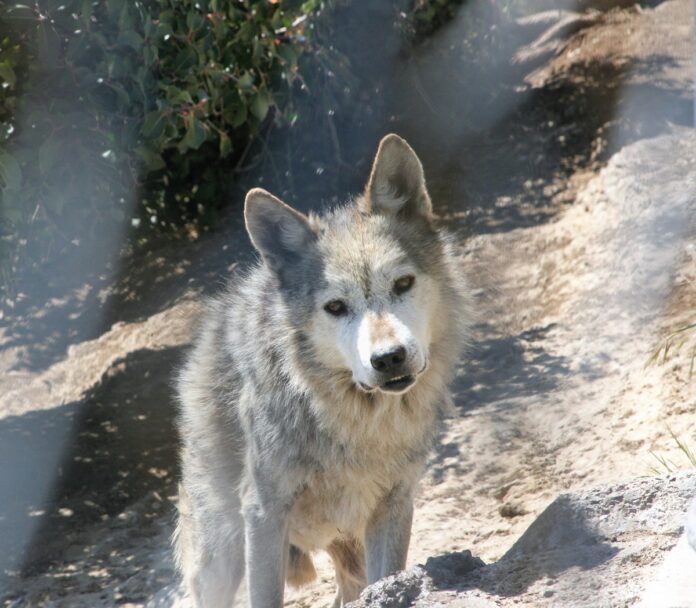Tucked away in the higher elevation of Julian, the California Wolf Center is a conservation, education and research facility currently home to 29 wolves in six packs, including four Northwestern gray wolves and 25 Mexican gray wolves, the most endangered wolf sub-species and one of the rarest land mammals on earth. With the combined efforts of wolf conservation centers across the states, the number of wolves is slowly climbing.
On Aug. 11, California Department of Fish and Wildlife announced that a new gray wolf pack was discovered in Tulare County. The new pack consists of five wolves, including one adult female who is the direct descendant of California’s first documented wolf in recent state history, Oregon wolf OR-7, who crossed the state line in 2011, with four offspring. Through genetic profiling from the offspring indicate the breeding male is a descendent of the Lassen Pack.
Today, California has seven confirmed
wolf packs: Whaleback Pack, Lassen Pack, Beckwourth Pack and an unnamed pack in Lassen, Plumas, Tehama, and Tulare counties.
CWC Executive Director Theresa Kosen said it has a population of wolves for educational and conservation efforts.
“Sometimes, people hear of them and want to see them,” she said. “They think they are going to have a very personal interaction with them, but that is not the intent. Our wolves are here for conservation, and they are wild. The Mexican gray wolf is really our call for conservation as they were the endangered sub-species that were near extinction that were brought in from the wild. We have been a part of reintroduction through very careful select breeding, and the sponsoring of puppies is the primary reintroduction now in the wild, back to their habitat.
We have regions in New Mexico and into Mexico itself. There are 60 organizations involved in the Mexican gray wolf SAFE (Saving Animals From Extinction) program.”
The CWC is a nonprofit and has several fall events coming up so that people can come, see the wolves, and help with the organization’s educational efforts.
On Sept. 16, 23 and 24, the CWC is bringing back its Apple Days Enrichment Tours where guests will have the opportunity to toss apple-based enrichment items to the ambassador wolves.
“We started specialty monthly tours that give visitors a little closer up experience which involves some sort of enrichment,” she said. “There are many forms of enrichments for wolves. We try to enrich the wolves here as much as possible, so they are healthy and happy. Enrichment can be a special food item, a special scent, or a physical enrichment to keep their muscles strong and useful.”
Kosen said the Apple Days Enrichment Tours coincides with Julian’s famous apple season.
“People who sign up for that enrichment tour can toss an enrichment that is apple-based up and over the enclosure to the wolves,” she said.
On Oct. 28 and 29, CWC will host its third annual Howl-O-Ween tours where wolves will be treated to special Halloween-themed enrichment items like pumpkins, all in a fun, spooky setting.
“Everybody loves Halloween, so we thought we should get into the spirit,” she said. “We do debunk many myths about wolves, some that are funny, some serious. We want to educate people that wolves are very much afraid of humans. The ‘Big, Bad, Wolf,’ does not really exist. It has been made up by Hollywood to be fierce and attacking. That is not at all how wolves are. People can dress up in costume and we’ll have appropriate enrichments for the wolves.”
The CWC will begin offering its wolf conservation tours in Spanish this fall. The Recorrido de la Conservation de Lobos tours will be offered on the first Sunday of each month.
Kosen said though they already knew, they did a visitor survey, and it confirmed that they had many Spanish speaking guests.
“We wanted to make sure we did more outreach to our Spanish-speaking visitors, residents, and visitors coming from across the border,” she said. “The Mexican gray wolf is in the northern states of Mexico, and we want to make sure we are speaking to the native Spanish speakers because it is important that they learn the importance of the return of the Mexican gray wolves to their native habitats.”
From Oct. 17, just in time for Wolf Awareness Week, the CWC will host a special edition of its ongoing series “Wolf Myths & Legends.” The fun and informative event will delve into wolf myths and legends from around the world, explore humankind’s attitudes about one of history’s most enigmatic predators, and discover why we have such a complicated relationship with the wolf.
“We want to make sure that we debunk some of the myths that give wolves a bad name,” she said. “We also celebrate some of the legends. We can celebrate wolves and find out how some of those myths and legends came to be.”
Kosen said the recent pack discovery was another step in the growth of the wolf population, and that they are being tracked by Fish and Wildlife.
Advanced reservations are required to visit CWC’s conservation facility, located 4.5 miles from downtown Julian. Public guided tours are offered Friday through Monday, and private group tours are available on weekdays. Visit www.californiawolfcenter.org.














